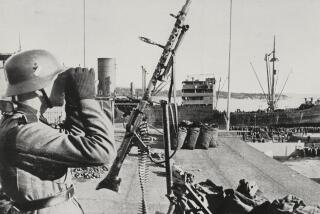Discovering Beauty in Norway’s Fiord Country
- Share via
There was as much sun in Lillesand that afternoon as there had been rain in Bergen the day before. It splashed in gold on the town’s grassy square, a block from the tiny harbor on Norway’s southern coast.
Baby strollers were parked near a glinting pretzel-and-crown sign at Knudsen’s bakery, while young mothers and their toddlers trooped inside. Crimson roses climbed over bright picket fences and around lamp posts.
The hammers of restoration crews tapped in the air in this proud town of white frame houses, which is a summer favorite of city folks from Oslo. Even Norway’s popular monarch, King Olav V, could not resist signing his name to a rock when he sailed his yacht in these waters. His royal graffito is the only such scribbling allowed in tiny Lillesand.
Lillesand was not on our cruise itinerary, which clearly said “Day At Sea.” It came as a sunny surprise, a makeup game for a rain-slogged stop in Bergen. Such improvisations are possible on smaller new cruise ships such as the Seabourn Pride, the Sea Goddess or the Wind Song. Such flexibility is welcomed by a new breed of traveler who does not believe that comfort and adventure are necessarily incompatible.
Our captain was Daniel Danielsen, a son of Lillesand who came out of retirement after a career with Royal Viking Line to launch the Seabourn fleet. His voice had boomed over the public address system that morning, inviting us to follow him home.
When we tied up at 2 p.m. his wife was at the pier, as were his daughter and grandsons. Several of the captain’s lifelong buddies joined in the welcome and lingered by the pier, swapping yarns.
As the town became our park for the day, so our ship became a local diversion. Towheaded boys hung by their knees from the thick ropes that linked vessel to shore. Children crowded by the gangway to wave and chatter for the visitors’ video cameras. Teen-agers on bicycles wheeled down the hill simply to stare at the streamlined ship, which would soon head south for the winter.
After admiring watercolors in an art gallery and ship models in the museum, I boarded a tender for a tour of the archipelago. Handsome cottages were tucked into forests of spruce and fir. Steep wooden ladders zigzagged up from the shore.
“Summer homes?” inquired an American.
“All are homes,” responded the earnest Norwegian boatman.
The deep woods and rock-bound shores reminded me of Mt. Desert Island in Maine, another enclave of timbered retreats that is ringed by bobbing masts. Lillesand has the same sense of tradition. It was a hard port to leave.
But from stem to stern--about as far as from Maine to Florida--Norway is seafaring country. Its Western fiords and sheltered waterways offer spectacular scenery and sailing. An armada of flat-rock islands called skerries forms a barrier against the wrath of the open sea. The Gulf Stream rules out ice.
Sognefiord is the largest and longest of the fingers of water, probing 125 miles inland to the hamlet of Flaam, with its cozy Fretheim Hotel. Geirangerfiord is reputedly the most beautiful, although the competition is so rigorous that I refuse to take a stand.
My favorite fiords may be the snug ones, such as the enchanting Trollfiord in the snowcapped Lofoten Islands north of the Arctic Circle.
A call in the Trollfiord is never guaranteed. It is a bonus of late light and calm winds. Your vessel cannot be too wide or long. Your captain cannot be too skittish.
I first sailed into that slip of deep water a dozen years ago aboard a Norwegian coastal steamer. Those sturdy ships sail every day, all year, from Bergen on the 2,500-mile round trip north to Kirkenes on the Russian border.
The coastal steamer is the Greyhound bus of Norway, stopping by night and day to deliver mail, furniture and people, caskets, prams and food. It is the only link for many far-flung villages.
There is a vast difference in price and amenities between the mail boat and most cruise ships.
On the mail boat Polarlys my cabin had narrow bunks and a single porthole with a heavy curtain to blot out the midnight sun. The bath was at the end of the hall. On the Seabourn Pride all cabins are suites and all windows are five feet wide.
But this much they have in common: Norwegian spunk and heritage, and enough maneuverability to sail into Trollfiord in the full of a moon and silently turn on a kroner.
It is a once-in-a-lifetime experience that I have been blessed to have twice.
More to Read
Sign up for The Wild
We’ll help you find the best places to hike, bike and run, as well as the perfect silent spots for meditation and yoga.
You may occasionally receive promotional content from the Los Angeles Times.






